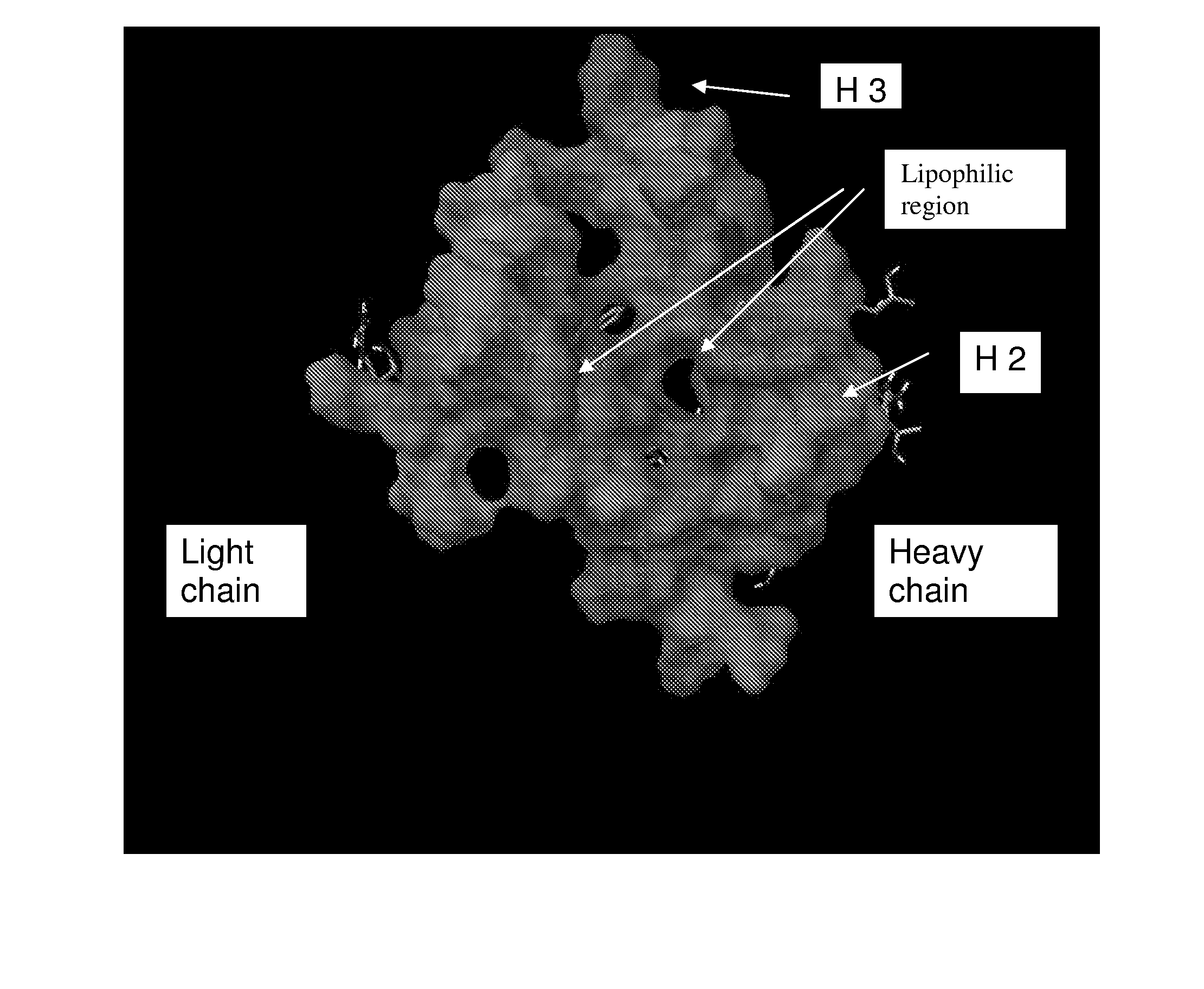Hepatitis c virus antibodies
a technology of hepatitis c virus and antibodies, which is applied in the field of humanized anti-hepatitis c virus antibodies, can solve the problems that none of these modifications were effective in restoring expression levels, and achieve the effect of broad-spectrum inhibitory effect on hcv infection
- Summary
- Abstract
- Description
- Claims
- Application Information
AI Technical Summary
Benefits of technology
Problems solved by technology
Method used
Image
Examples
example 1
Materials and Methods
Cloning of Humanized V Genes
[0375]The heavy chain V regions (see Example 2) were cloned into pG1D200 via HindIII and ApaI restriction enzyme sites. Similarly, the light chain V regions were cloned into pKN100 via the HindIII and BamHI sites. pG1D200 vector were prepared for ligation by digesting 5 μg of DNA with 20 units of HindIII and ApaI in multicore (Promega) restriction digest buffer for 2 hrs at 37° C. Then 1 unit of shrimp alkaline phosphatase was added for 30 min at 37° C. and inactivated at 65° C. for 20 minutes. The vector preparation was then purified on a Qiaquick (Qiagen) column following manufacturer's instructions. The vector was eluted in 50 μl. Similarly pKN100 vector was prepared by digesting 5 μg of DNA with 20 units of HindIII and BamHI in buffer E (Promega) for 1 hour at 37° C. The DNA was treated with shrimp alkaline phosphatase and purified as described above. V region DNA including mutant V regions was supplied by GENART in the vectors pG...
example 2
Selection of a Human VH Framework for AP33RHA
[0394]Human VH sequences with highest identity to AP33 VH at Vernier, Canonical and VL Interface residues (VCI residues) and which have the same size of CDR1 and 2, are shown in FIG. 14 and are used to select the optimal donor framework. See Foote J. and Winter G., J Mol Biol 224:487-99 (1992) and Chothia C. et al., J Mol Biol 186:651-63 (1985). The FW identity scores are also shown. Sequences which are humanized antibodies, mouse antibodies or scFv have also been omitted, except for A03907, the D1.3 mouse anti-lysozyme VH. The interface residues tend to be buried, away from the CDRs, whereas Vernier and Canonical residues tend to be close to CDRs.
[0395]With respect to overall VCI identity, U86525 had the highest score (14 out of 17 for VCI score and 80 out of 86 for the framework score) (FIG. 14). The top 18 human sequences all had a VCI score of 14 whilst the framework scores varied from 61 out of 86 or less. The VCI residue differences...
example 3
Selection of a Leader Sequence for AP33RHA
[0397]The initial humanization is the graft of the Kabat CDRs 1, 2 and 3 from AP33VH into the acceptor S67826 Kabat FWs 1, 2, 3, 4 (FIG. 18). This sequence requires the addition of a signal peptide from the germline gene VH4-59 that has the closest sequence identity to S67826 (FIG. 17). We used the SignalP (Foote J. and Winter G., J Mol Biol 224:487-99 (1992)) (V2.0.b2) server to confirm that this leader (FIG. 17) would cut with signal peptidase when preceding the 567826 FW1 sequence. FIG. 18 shows the generation of AP33RHA protein and DNA sequence by intercalating the AP33 CDRs into the human FW. The DNA sequence of AP33RHA including its leader is shown below (previously Table 13 in 61 / 006,066):
ATGAAACATCTGTGGTTCTTCCTTCTGCTGGTGGCAGCTCCCAGATGGGTCCTGTCCcaggtgcagctgcaggagtcgggcccaggactggtgaagccttcggagaccctgtccctcacctgcactgtctctggtgactccatcagtAGTGGTTACTGGAACatccggcagcccccagggagggcactggagtggataggaTACATAAGTTACAGTGGTAGCACTTACTACAATCTATCTCTCAGAAGTc...
PUM
| Property | Measurement | Unit |
|---|---|---|
| pH | aaaaa | aaaaa |
| diameter | aaaaa | aaaaa |
| time | aaaaa | aaaaa |
Abstract
Description
Claims
Application Information
 Login to View More
Login to View More - R&D
- Intellectual Property
- Life Sciences
- Materials
- Tech Scout
- Unparalleled Data Quality
- Higher Quality Content
- 60% Fewer Hallucinations
Browse by: Latest US Patents, China's latest patents, Technical Efficacy Thesaurus, Application Domain, Technology Topic, Popular Technical Reports.
© 2025 PatSnap. All rights reserved.Legal|Privacy policy|Modern Slavery Act Transparency Statement|Sitemap|About US| Contact US: help@patsnap.com



